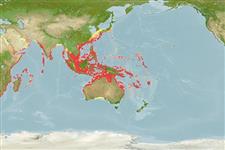Classification / Names
Common names from other countries
Main reference
आकार / वज़न / Age
Max length : 120 cm TL पुल्लिंग / अलिंग; (Ref. 47613); अधिकतम प्रकाशित वज़न: 15.0 kg (Ref. 11228); अधिकतम सूचित उम्र: 22 वर्षो (Ref. 3627)
Length at first maturity
Lm 48.3, range 25 - 30 cm
पर्यावरण
; समुद्री; खारा प्रवाल-भित्ति संयुक्त; गहराई सीमा 1 - 100 m (Ref. 167)
जलवायु / सीमा
Subtropical, preferred 28°C (Ref. 107945); 37°N - 34°S, 28°E - 180°E (Ref. 5222)
वितरण
Indo-West Pacific: Red Sea south to at least Durban, South Africa and eastward to Palau and Fiji, north to the Ryukyu Islands, south to the Arafura Sea (Ref. 9819) and Australia. Recently reported from the Mediterranean coast of Israel (Ref. 5222). Frequently misidentified as Epinephelus tauvina or Epinephelus malabaricus (Ref. 27362).
देश | ऐफ ऐ ओ क्षेत्र | Ecosystems | संयोग | भूमिका
Short description
पृष्ठीय रीढ़ (सम्पूर्ण): 11; पृष्ठीय सौफट रेज़ (सम्पूर्ण): 13-16; गुदा कांटा 3; ऐनल सौफट रेज़: 8. Small individuals closely resemble E. tauvinaand E. malabaricus, but have orange spots and lack hexagonal spots on the fins (Ref. 37816); head and body tan dorsally, shading to whitish ventrally; numerous small brownish orange or reddish brown spots on head, body and median fins (Ref. 89707); further characterized by having overall tan color; four irregular H-shaped dark bars; back with 3-4 blackish saddles; head, body and fins with numerous small brownish orange or reddish brown spots; body scales ctenoid except for nape, back, thorax, abdomen and above anal-fin base with cycloid scales; greatest depth of body 2.9-3.7 in SL; rounded caudal fin; short pelvic fins, 1.9-2.7 in head length (Ref. 90102).
IUCN Red List Status (Ref. 115185)
Threat to humans
Harmless
Human uses
मात्स्यिकी: व्यापारिक; जलीयकृषि: व्यापारिक
अधिक जानकारी
संदर्भजलीयकृषिजलीयकृषि रूपरेखाखींचआनुवंशिकीऐल्लि आवृतियाँहैरेटिबिलटीबीमारीप्रक्रमणMass conversion
सहयोगीयोतस्वीरेStamps, Coinsध्वनिसिगुयटिरारफ्तारतैरने के प्रकारगिल क्षेत्रOtolithsदिमागदृष्टि
साधन
Special reports
Download XML
इंटरनेट स्रोत
Estimates of some properties based on models
Phylogenetic diversity index
PD50 = 0.5000 many relatives (e.g. carps) 0.5 - 2.0 few relatives (e.g. lungfishes)
Trophic Level
4.0 ±0.0 se; Based on diet studies.
लौटाव
निम्न, न्यूनतम जनसंख्या दुगनी होने का समय 4.5 - 14 वर्ष। (K=0.17; tm=2-3; tmax=22; Fec=43,618)
Vulnerability
High vulnerability (58 of 100)
Price category
